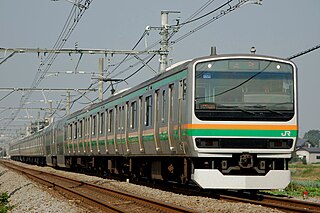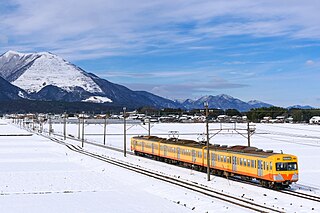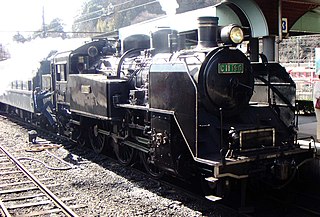
The Tōkaidō Main Line is one of the most important railway corridors in Japan, connecting the major cities of Tokyo and Kobe via Shizuoka, Nagoya, Kyoto and Osaka. The line, with termini at Tokyo and Kobe stations, is 589.5 km (366.3 mi) long, not counting its many freight feeder lines around the major cities. The high-speed Tōkaidō Shinkansen largely parallels the line.

The Osaka Loop Line is a railway loop line in Japan operated by the West Japan Railway Company. It encircles central Osaka.

The Aoimori Railway Line is a regional rail line in Aomori Prefecture, Japan that is operated by the Aoimori Railway Company. It connects the terminal station of the Iwate Galaxy Railway Line, Metoki Station, in the town of Sannohe to Aomori Station, the terminus of several rail lines in the city of Aomori. The Aoimori and Iwate Galaxy Railway Lines are former sections of the Tōhoku Main Line that connected Tokyo to Aomori that were rendered obsolete for long-distance passenger services by the completion of the high-speed Tōhoku Shinkansen between Tokyo and Shin-Aomori stations. Though local passenger services are run on the line by the Aoimori Railway Company, the East Japan Railway Company continues to operate limited services, such as the sightseeing train Resort Asunaro, along the line, and the Japan Freight Railway Company transports freight along the line.

The Nambu Line is a Japanese railway line which connects Tachikawa Station in Tachikawa, Tokyo and Kawasaki Station in Kawasaki, Kanagawa. For most of its length, it parallels the Tama River, the natural border between Tokyo and Kanagawa prefectures. It lies along the Tama Hills. It is part of the East Japan Railway Company network. The line forms part of what JR East refers to as the "Tokyo Mega Loop" around Tokyo, consisting of the Keiyo Line, Musashino Line, Nambu Line, and the Yokohama Line. The name refers to the southern part of the ancient province of Musashi, through which the Nambu Line runs.

The Sagami Railway Company, Ltd., or Sōtetsu (相鉄), is a private railway company operating three lines in Kanagawa Prefecture, Japan. It is a wholly owned subsidiary of holding company Sōtetsu Holdings, Inc. Sōtetsu Holdings is listed on the Tokyo Stock Exchange; 6.58% of it is owned by the Odakyu Electric Railway Company.

The Tobu Railway Company, Ltd. is a Japanese commuter railway and keiretsu holding company in the Greater Tokyo Area as well as an intercity and regional operator in the Kantō region. Excluding the Japan Railways Group companies, Tobu's 463.3 km (287.9 mi) rail system is the second longest in Japan after Kintetsu. It serves large portions of Saitama Prefecture, Gunma Prefecture and Tochigi Prefecture, as well as northern Tokyo and western Chiba Prefecture. The Tobu Railway Company is listed in the First Section of the Tokyo Stock Exchange and is a constituent of the Nikkei 225 index.

The Musashino Line is a railway line operated by the East Japan Railway Company. It links Tsurumi Station in Yokohama with Nishi-Funabashi Station in Chiba Prefecture, forming a 100.6 km (62.5 mi) unclosed loop around central Tokyo. Passenger operations are limited to the 71.8 km (44.6 mi) portion between Fuchūhommachi and Nishi-Funabashi; the Tsurumi to Fuchūhommachi portion, called the "Musashino South Line", is normally used only by freight trains. The line forms part of what JR East refers to as the "Tokyo Mega Loop" around Tokyo, consisting of the Keiyō Line, Musashino Line, Nambu Line, and Yokohama Line.

The Agatsuma Line is a local rail line in Gunma, Japan, and is part of the East Japan Railway Company network. Approximately following the Agatsuma River, it is 55.6 km between Shibukawa and Ōmae stations.

The Takasaki Line is a Japanese railway line which connects Ōmiya Station in Saitama, Saitama Prefecture and Takasaki Station in Takasaki, Gunma Prefecture. It is owned and operated by the East Japan Railway Company.

The Tsurumi Line is a group of 3 railway lines operated by East Japan Railway Company in Kanagawa Prefecture, Japan. Originally built to service the port and adjacent industrial area, the lines provide passenger services along a line between Tsurumi Station in Tsurumi-ku, Yokohama and Ōgimachi Station in Kawasaki-ku, Kawasaki, and 2 short branches with a total length of track to 9.7 km (6.0 mi). The gauge is 1,067 mm, two sections of the line have double track and the line is electrified at 1,500 V DC.

The Nikkō Line is a railway line operated by East Japan Railway Company which connects Utsunomiya to Nikkō.
Ichibata Electric Railway Co., Ltd. is the name of two related, yet different companies in Shimane Prefecture, Japan. Ichibata Denki Tetsudō Kabushiki-gaisha (一畑電気鉄道株式会社) was a railway operator until 2006, when it became a holding company of the Ichibata Group, spinning off its railway division to its newly founded Ichibata Densha Kabushiki-gaisha (一畑電車株式会社). Although the two companies have different names in Japanese, in English they are referred to by the English name of their parent holding company.

The Shinetsu Main Line is a railway line, consisting of three geographically separated sections, operated by the East Japan Railway Company in Japan. It was originally one continuous line connecting Takasaki and Niigata via Nagano. Since the opening and later extension of the Hokuriku Shinkansen, sections running in parallel have either been discontinued or transferred to third-sector railway companies.

The Chōshi Electric Railway Line is a 6.4 km (4.0 mi) long railway line operated by the privately owned Chōshi Electric Railway between Chōshi and Tokawa stations in Chiba Prefecture, Japan.

The Nagano Electric Railway is a private railway based in Nagano, Japan. The company and its line are commonly referred to as Nagaden (長電). It originally operated three lines, but only the Nagano Line between Nagano — Suzaka — Shinshū-Nakano — Yudanaka remains in service. Nagaden owns a 1.1% stake in Shinano Railway.

The Joshin Line is a Japanese railway line in Gunma Prefecture, between Takasaki Station in Takasaki and Shimonita Station in Shimonita, operated by the private railway operator Joshin Electric Railway. This is the only line operated by the company, although it also operates a few bus lines. The first section of the line opened in 1897.

Sangi Railway Co., Ltd. is a private railway company in Mie Prefecture, Japan, which also operates bus lines. The company was founded in 1928 and its initial line, the Sangi Line, originally functioned as a freight line transporting cement, but later developed into an important commuter railway line for Yokkaichi. The Hokusei Line was transferred from Kintetsu ownership in 2003 when Kintetsu abandoned the line. Whereas the Sangi Line has a track gauge of 1,067 mm, the Hokusei Line is one of only a few 762 mm narrow gauge lines remaining in the country.

The Ōigawa Main Line is a Japanese railway line which connects Kanaya Station in Shimada, Shizuoka Prefecture with Senzu Station in Kawanehon, Haibara District, Shizuoka Prefecture. It is owned and operated by the private railway operator Ōigawa Railway.

The San'yō Main Line is a major railway line owned by JR Group companies in western Japan, connecting Kōbe Station and Moji Station, largely paralleling the coast of the Seto Inland Sea, in other words, the southern coast of western Honshu. The San'yō Shinkansen line largely parallels its route. The name Sanyō derived from the ancient region and highway San'yōdō, the road on the sunny (south) side of the mountains.

The Choshi Electric Railway 100 series was an electric multiple unit (EMU) train type operated by the private railway operator Choshi Electric Railway in Chiba Prefecture, Japan, between 1939 and 1999.



















